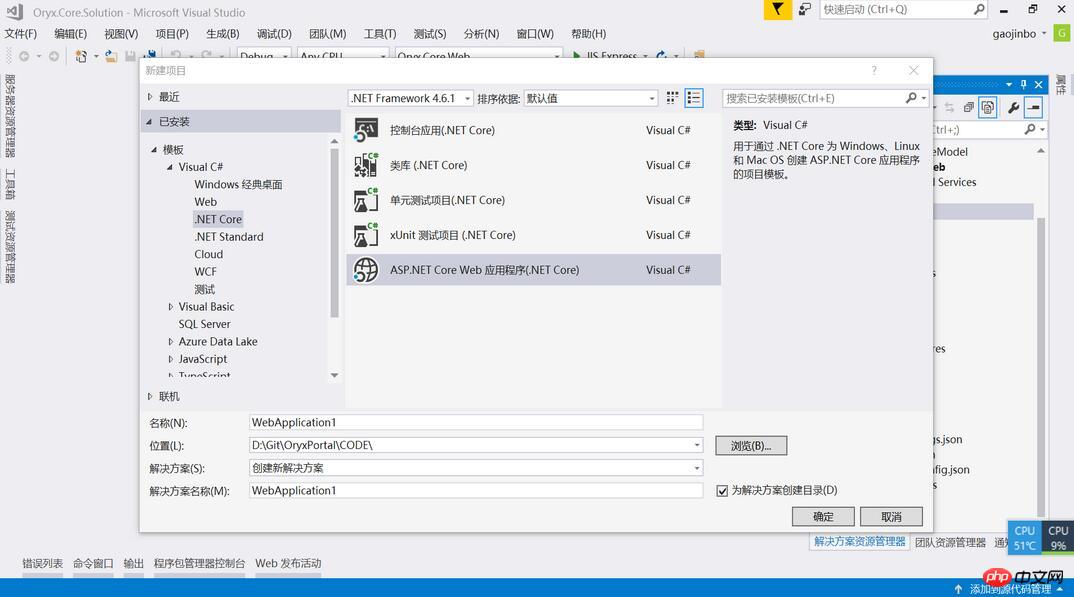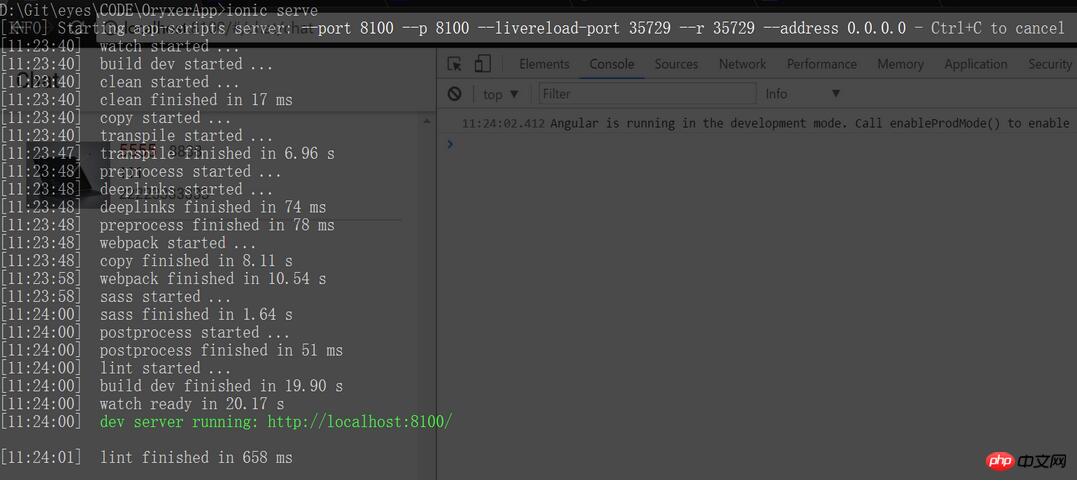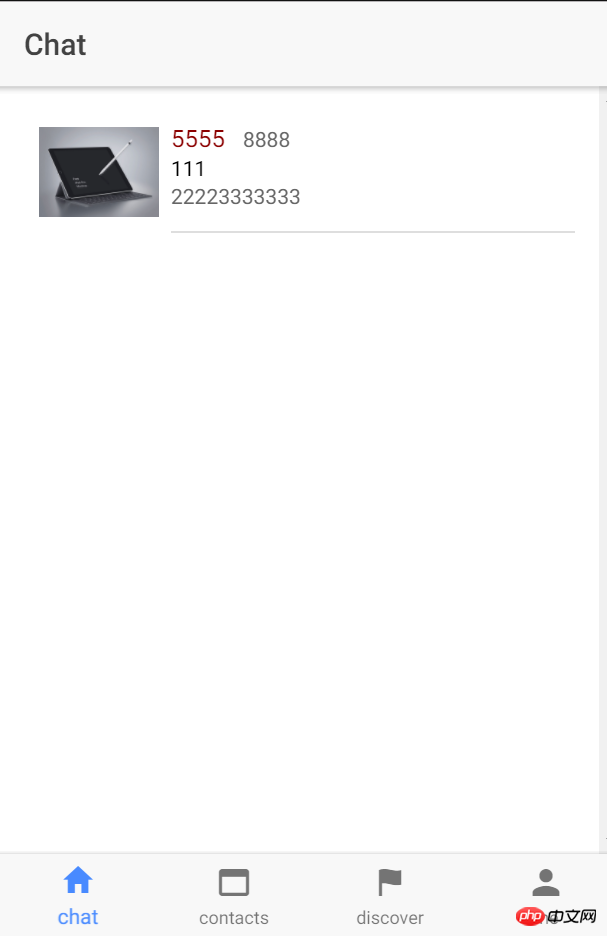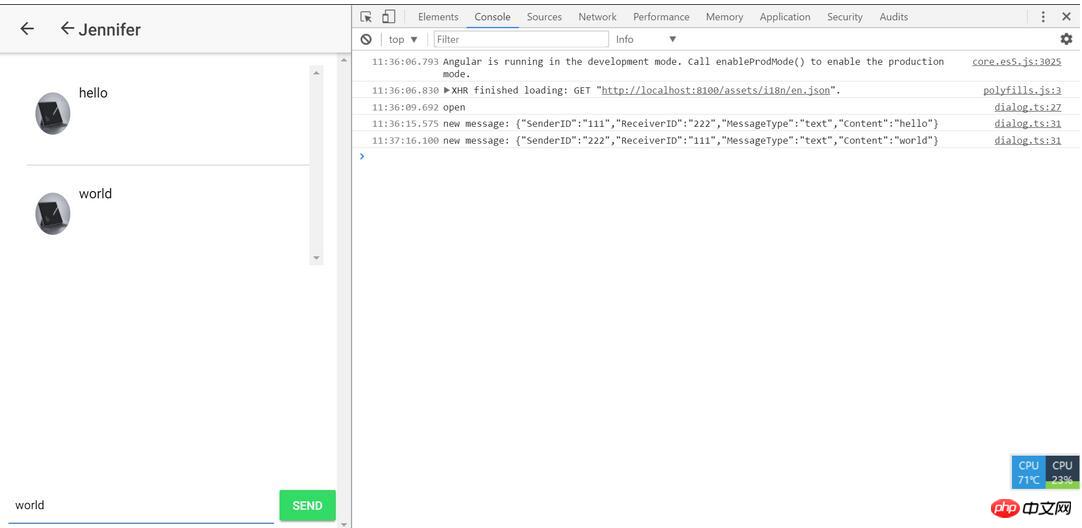 Backend Development
Backend Development
 C#.Net Tutorial
C#.Net Tutorial
 Detailed explanation of creating NetCore WebSocket instant messaging instance
Detailed explanation of creating NetCore WebSocket instant messaging instance
Detailed explanation of creating NetCore WebSocket instant messaging instance
This article mainly introduces the NetCore WebSocket instant messaging example in detail, which has certain reference value. Interested friends can refer to
NetCore WebSocket instant messaging example for your reference. The content is as follows
1. Create a new Netcore Web project

2. Create a simple communication protocol
public class MsgTemplate
{
public string SenderID { get; set; }
public string ReceiverID { get; set; }
public string MessageType { get; set; }
public string Content { get; set; }
}SenderID Sender ID
ReceiverID Receiver ID
MessageType Message Type Text Voice etc.
Content Message content
3. Add middleware ChatWebSocketMiddleware
public class ChatWebSocketMiddleware
{
private static ConcurrentDictionary<string, System.Net.WebSockets.WebSocket> _sockets = new ConcurrentDictionary<string, System.Net.WebSockets.WebSocket>();
private readonly RequestDelegate _next;
public ChatWebSocketMiddleware(RequestDelegate next)
{
_next = next;
}
public async Task Invoke(HttpContext context)
{
if (!context.WebSockets.IsWebSocketRequest)
{
await _next.Invoke(context);
return;
}
System.Net.WebSockets.WebSocket dummy;
CancellationToken ct = context.RequestAborted;
var currentSocket = await context.WebSockets.AcceptWebSocketAsync();
//string socketId = Guid.NewGuid().ToString();
string socketId = context.Request.Query["sid"].ToString();
if (!_sockets.ContainsKey(socketId))
{
_sockets.TryAdd(socketId, currentSocket);
}
//_sockets.TryRemove(socketId, out dummy);
//_sockets.TryAdd(socketId, currentSocket);
while (true)
{
if (ct.IsCancellationRequested)
{
break;
}
string response = await ReceiveStringAsync(currentSocket, ct);
MsgTemplate msg = JsonConvert.DeserializeObject<MsgTemplate>(response);
if (string.IsNullOrEmpty(response))
{
if (currentSocket.State != WebSocketState.Open)
{
break;
}
continue;
}
foreach (var socket in _sockets)
{
if (socket.Value.State != WebSocketState.Open)
{
continue;
}
if (socket.Key == msg.ReceiverID || socket.Key == socketId)
{
await SendStringAsync(socket.Value, JsonConvert.SerializeObject(msg), ct);
}
}
}
//_sockets.TryRemove(socketId, out dummy);
await currentSocket.CloseAsync(WebSocketCloseStatus.NormalClosure, "Closing", ct);
currentSocket.Dispose();
}
private static Task SendStringAsync(System.Net.WebSockets.WebSocket socket, string data, CancellationToken ct = default(CancellationToken))
{
var buffer = Encoding.UTF8.GetBytes(data);
var segment = new ArraySegment<byte>(buffer);
return socket.SendAsync(segment, WebSocketMessageType.Text, true, ct);
}
private static async Task<string> ReceiveStringAsync(System.Net.WebSockets.WebSocket socket, CancellationToken ct = default(CancellationToken))
{
var buffer = new ArraySegment<byte>(new byte[8192]);
using (var ms = new MemoryStream())
{
WebSocketReceiveResult result;
do
{
ct.ThrowIfCancellationRequested();
result = await socket.ReceiveAsync(buffer, ct);
ms.Write(buffer.Array, buffer.Offset, result.Count);
}
while (!result.EndOfMessage);
ms.Seek(0, SeekOrigin.Begin);
if (result.MessageType != WebSocketMessageType.Text)
{
return null;
}
using (var reader = new StreamReader(ms, Encoding.UTF8))
{
return await reader.ReadToEndAsync();
}
}
}
}Control that only the recipient can receive the message
##
if (socket.Key == msg.ReceiverID || socket.Key == socketId)
{
await SendStringAsync(socket.Value,JsonConvert.SerializeObject(msg), ct);
}app.UseWebSockets(); app.UseMiddleware<ChatWebSocketMiddleware>();

For example, if the ionic-cli initialization project fails, just switch to the default npmorg source.For example, if ionic serve fails, just open the proxy and allow FQ.The interface after startup is like this


export class Dialog {
private ws: any;
private msgArr: Array<any>;
constructor(private httpService: HttpService) {
this.msgArr = [];
}
ionViewDidEnter() {
if (!this.ws) {
this.ws = new WebSocket("ws://localhost:56892?sid=222");
this.ws.onopen = () => {
console.log('open');
};
this.ws.onmessage = (event) => {
console.log('new message: ' + event.data);
var msgObj = JSON.parse(event.data);
this.msgArr.push(msgObj);;
};
this.ws.onerror = () => {
console.log('error occurred!');
};
this.ws.onclose = (event) => {
console.log('close code=' + event.code);
};
}
}
sendMsg(msg) {//msg为我要发送的内容 比如"hello world"
var msgObj = {
SenderID: "222",
ReceiverID: "111",
MessageType: "text",
Content: msg
};
this.ws.send(JSON.stringify(msgObj));
}sid represents the unique identification of WebSocke on my end. If you find this key, you can find my client.
<p class="container" style="width:90%;margin:0px auto;border:1px solid steelblue;"> <p class="msg"> <p id="msgs" style="height:200px;"></p> </p> <p style="display:block;width:100%"> <input type="text" style="max-width:unset;width:100%;max-width:100%" id="MessageField" placeholder="type message and press enter" /> </p> </p>
<script>
$(function () {
$('.navbar-default').addClass('on');
var userName = '@Model';
var protocol = location.protocol === "https:" ? "wss:" : "ws:";
var wsUri = protocol + "//" + window.location.host + "?sid=111";
var socket = new WebSocket(wsUri);
socket.onopen = e => {
console.log("socket opened", e);
};
socket.onclose = function (e) {
console.log("socket closed", e);
};
socket.onmessage = function (e) {
console.log(e);
var msgObj = JSON.parse(e.data);
$('#msgs').append(msgObj.Content + '<br />');
};
socket.onerror = function (e) {
console.error(e.data);
};
$('#MessageField').keypress(function (e) {
if (e.which != 13) {
return;
}
e.preventDefault();
var message = $('#MessageField').val();
var msgObj = {
SenderID:"111",
ReceiverID:"222",
MessageType: "text",
Content: message
};
socket.send(JSON.stringify(msgObj));
$('#MessageField').val('');
});
});
</script>



The above is the detailed content of Detailed explanation of creating NetCore WebSocket instant messaging instance. For more information, please follow other related articles on the PHP Chinese website!

Hot AI Tools

Undresser.AI Undress
AI-powered app for creating realistic nude photos

AI Clothes Remover
Online AI tool for removing clothes from photos.

Undress AI Tool
Undress images for free

Clothoff.io
AI clothes remover

Video Face Swap
Swap faces in any video effortlessly with our completely free AI face swap tool!

Hot Article

Hot Tools

Notepad++7.3.1
Easy-to-use and free code editor

SublimeText3 Chinese version
Chinese version, very easy to use

Zend Studio 13.0.1
Powerful PHP integrated development environment

Dreamweaver CS6
Visual web development tools

SublimeText3 Mac version
God-level code editing software (SublimeText3)

Hot Topics
 1663
1663
 14
14
 1420
1420
 52
52
 1313
1313
 25
25
 1266
1266
 29
29
 1239
1239
 24
24
 How to achieve real-time communication using PHP and WebSocket
Dec 17, 2023 pm 10:24 PM
How to achieve real-time communication using PHP and WebSocket
Dec 17, 2023 pm 10:24 PM
With the continuous development of Internet technology, real-time communication has become an indispensable part of daily life. Efficient, low-latency real-time communication can be achieved using WebSockets technology, and PHP, as one of the most widely used development languages in the Internet field, also provides corresponding WebSocket support. This article will introduce how to use PHP and WebSocket to achieve real-time communication, and provide specific code examples. 1. What is WebSocket? WebSocket is a single
 The combination of Java and WebSocket: how to achieve real-time video streaming
Dec 17, 2023 pm 05:50 PM
The combination of Java and WebSocket: how to achieve real-time video streaming
Dec 17, 2023 pm 05:50 PM
With the continuous development of Internet technology, real-time video streaming has become an important application in the Internet field. To achieve real-time video streaming, the key technologies include WebSocket and Java. This article will introduce how to use WebSocket and Java to implement real-time video streaming playback, and provide relevant code examples. 1. What is WebSocket? WebSocket is a protocol for full-duplex communication on a single TCP connection. It is used on the Web
 PHP and WebSocket: Best practices for real-time data transfer
Dec 18, 2023 pm 02:10 PM
PHP and WebSocket: Best practices for real-time data transfer
Dec 18, 2023 pm 02:10 PM
PHP and WebSocket: Best Practice Methods for Real-Time Data Transfer Introduction: In web application development, real-time data transfer is a very important technical requirement. The traditional HTTP protocol is a request-response model protocol and cannot effectively achieve real-time data transmission. In order to meet the needs of real-time data transmission, the WebSocket protocol came into being. WebSocket is a full-duplex communication protocol that provides a way to communicate full-duplex over a single TCP connection. Compared to H
 How to use Java and WebSocket to implement real-time stock quotation push
Dec 17, 2023 pm 09:15 PM
How to use Java and WebSocket to implement real-time stock quotation push
Dec 17, 2023 pm 09:15 PM
How to use Java and WebSocket to implement real-time stock quotation push Introduction: With the rapid development of the Internet, real-time stock quotation push has become one of the focuses of investors. The traditional stock market push method has problems such as high delay and slow refresh speed. For investors, the inability to obtain the latest stock market information in a timely manner may lead to errors in investment decisions. Real-time stock quotation push based on Java and WebSocket can effectively solve this problem, allowing investors to obtain the latest stock price information as soon as possible.
 SSE and WebSocket
Apr 17, 2024 pm 02:18 PM
SSE and WebSocket
Apr 17, 2024 pm 02:18 PM
In this article, we will compare Server Sent Events (SSE) and WebSockets, both of which are reliable methods for delivering data. We will analyze them in eight aspects, including communication direction, underlying protocol, security, ease of use, performance, message structure, ease of use, and testing tools. A comparison of these aspects is summarized as follows: Category Server Sent Event (SSE) WebSocket Communication Direction Unidirectional Bidirectional Underlying Protocol HTTP WebSocket Protocol Security Same as HTTP Existing security vulnerabilities Ease of use Setup Simple setup Complex performance Fast message sending speed Affected by message processing and connection management Message structure Plain text or binary Ease of use Widely available Helpful for WebSocket integration
 How does Java Websocket implement online whiteboard function?
Dec 17, 2023 pm 10:58 PM
How does Java Websocket implement online whiteboard function?
Dec 17, 2023 pm 10:58 PM
How does JavaWebsocket implement online whiteboard function? In the modern Internet era, people are paying more and more attention to the experience of real-time collaboration and interaction. Online whiteboard is a function implemented based on Websocket. It enables multiple users to collaborate in real-time to edit the same drawing board and complete operations such as drawing and annotation. It provides a convenient solution for online education, remote meetings, team collaboration and other scenarios. 1. Technical background WebSocket is a new protocol provided by HTML5. It implements
 golang WebSocket programming tips: handling concurrent connections
Dec 18, 2023 am 10:54 AM
golang WebSocket programming tips: handling concurrent connections
Dec 18, 2023 am 10:54 AM
Golang is a powerful programming language, and its use in WebSocket programming is increasingly valued by developers. WebSocket is a TCP-based protocol that allows two-way communication between client and server. In this article, we will introduce how to use Golang to write an efficient WebSocket server that handles multiple concurrent connections at the same time. Before introducing the techniques, let's first learn what WebSocket is. Introduction to WebSocketWeb
 How to use WebSocket for file transfer in golang
Dec 18, 2023 am 09:06 AM
How to use WebSocket for file transfer in golang
Dec 18, 2023 am 09:06 AM
How to use WebSocket for file transfer in golang WebSocket is a network protocol that supports two-way communication and can establish a persistent connection between the browser and the server. In golang, we can use the third-party library gorilla/websocket to implement WebSocket functionality. This article will introduce how to use golang and gorilla/websocket libraries for file transfer. First, we need to install gorilla



